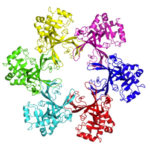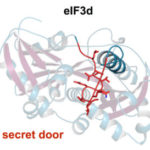The work of Eva Nogales and Jennifer Doudna, Molecular Biophysics & Integrated Bioimaging Division faculty scientists, were highlighted in the August 18 Nature technology feature article, “Let the structural symphony begin,” a discussion of the current “golden time to do hybrid methodologies,” according to Nogales. Structural biologists, such as Nogales who was interviewed for this article, now have “the tools to tackle important questions about cells’ molecular machinery that would have been impossible to answer just a few years ago.” Combining these imaging methods – selecting from an impressive suite of different imaging techniques – is an increasingly popular approach in the field of structural biology, in which X-ray crystallography has been the premier method for more than a century. According to the article, while “the most powerful insights come from (these) hybrid methodologies that integrate images from several different tools, ” it also has its drawbacks. Read the full article here.
Fleming Honored by Japanese Chemical Society
Graham R. Fleming, senior scientist in the Molecular Biophysics & Integrated Bioimaging Division, has been named an Honorary Member of the Chemical Society of Japan (CSJ). The award will be presented at the 97th CSJ Annual Meeting in March 2017. Fleming will join a select group of only fourteen living honorary members, five of whom are Nobel Laureates. The society was founded in 1878. With its current membership exceeding 34,000, it is one of the most affluent academic societies in Japan, covering most areas of pure and applied chemistry.
Biosciences Technology Among R&D 100 Award Finalists
A technology developed by Diane Bryant and Simon Morton, of the Molecular Biophysics & Integrated Bioimaging Division, has been named a 2016 R&D 100 Award finalist. The Compact Dynamic Beamstop (CDBS), a compact, customizable tool for X-ray scattering experiments providing real-time data, is one of seven Berkeley Lab technologies plus one multi-lab nomination including the Lab that made the list of finalists.
Widely recognized in industry, government, and academia as a mark of excellence for the most innovative ideas of the year, the R&D 100 Awards are the only industry-wide competition rewarding the practical applications of science. They recognize the most promising new products, processes, materials, or software developed throughout the world and introduced to the market the previous year. This year’s 100 award winners will be announced in November.
Study Finds Molecular Switch That Triggers Bacterial Pathogenicity
Scientists have revealed that the supercoiling of bacterial chromosomes around histone-like proteins can trigger the expression of genes that make the microbe invasive. The discovery could provide a new target for the development of drugs to prevent or treat bacterial infection.
The study lead author Michal Hammel, research scientist in the Molecular Biophysics & Integrated Bioimaging (MBIB) Division, teamed up with MBIB faculty scientist Carolyn Larabell; both are pictured above. Read more on the Berkeley Lab News Center.
When Targeting Cancer Genes, Zero in on the One Percent
UC Berkeley researchers have found a promising new drug target within the pathway that controls production of a cell’s thousands of proteins. That is appealing, in part, because it appears to control production of only a few percent of the body’s many proteins, those critical to regulating the growth and proliferation of cells. The study was led by Jamie Cate, a faculty scientist in Berkeley Lab’s Molecular Biophysics & Integrated Bioimaging Division. Read more on UC Berkeley News.
- « Previous Page
- 1
- …
- 64
- 65
- 66
- 67
- 68
- …
- 78
- Next Page »
Was this page useful?








